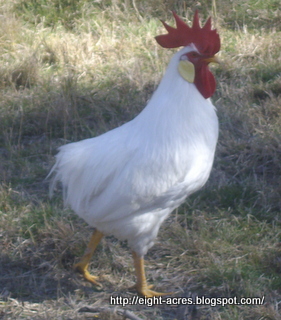 |
| a free-ranging hen |
My all time most popular post is the first one I wrote about
chicken tractors, I had no idea that it would be so useful or interesting, so I
wrote a few follow-up posts this year with as much detail as I could think
of. We also made a new tractor, so I was
able to follow the process from start to finish and write a nice detailed post. Our chickens spend the day in their tractors and the afternoon free-ranging (if they're well-behaved).
 |
| the new chicken tractor |
 |
| some chickens demonstrating one of the old tractors |
Incubator intricacies... Caring for baby chicks Buying new chickens Determining the gender of young chickens Why choose heritage breeds of chickens and vegetables |
If you want chicks, you need a rooster (or three) and I
wrote a bit about our crazy roosters.
And then how to butcher them….
I solved a few common chicken problems…
Experimented with different chicken feeds….
And recommended an excellent chicken book
 |
| more hens.... |
By the way, my chicken eBook is now available if you want to know more about backyard chickens and using chicken tractors. More information over at the chicken tractor ebook blog. Or you can get it directly from my shop on Etsy (.pdf format), or Amazon Kindle or just send me an email eight.acres.liz {at} gmail.com.
or just send me an email eight.acres.liz {at} gmail.com.
What's the eBook about?
Chickens in a confined coop can end up living in an unpleasant dust-bowl, but allowing chickens to free-range can result in chickens getting into gardens and expose them to predators.
What's the eBook about?
Chickens in a confined coop can end up living in an unpleasant dust-bowl, but allowing chickens to free-range can result in chickens getting into gardens and expose them to predators.
A movable cage or “chicken tractor” is the best of both options – the chickens are safe, have access to clean grass, fresh air and bugs. Feed costs are reduced, chickens are happier, and egg production increases.
But how do you build a chicken tractor? What aspects should be considered in designing and using a chicken tractor effectively? In this eBook I aim to explain how to make a chicken tractor work for you in your environment to meet your goals for keeping chickens.
I also list what I have learnt over 10 years of keeping chickens in tractors of various designs and sizes, from hatching chicks, through to butchering roosters.
Reviews of the Design and Use a Chicken Tractor
Chris from Gully Grove
Going Grey and Slightly Green
Chris from Gully Grove
Going Grey and Slightly Green







A perfectly timed post for Vicki and I Liz. Thank you so much. :)
ReplyDeleteOh my goodness Liz...you really should do a blog post on the deck chicken one day. She's my absolute favourite! (though Boris looks like he could one day be a contender :)
ReplyDeleteHappy to help. Yes deck chicken is hilarious, I don't know if she's learning, but she hasn't been up on the deck for a while, maybe she will become a normal chicken in the end...
ReplyDelete